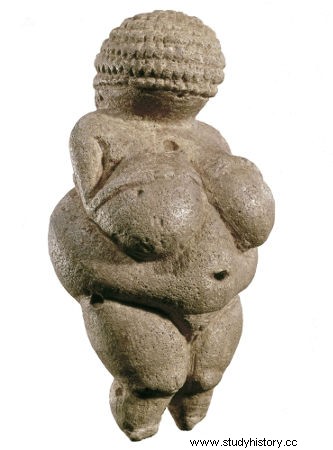See the image of one of the most famous prehistoric sculptures, the “Venus of Willendorf”.

Venus of Willendorf
About this sculpture, it is correct to say that:
a) was found in the archaeological site of Serra da Capivara, in the south of Piauí.
b) was discovered in 1990 by an archaeologist named Willendorf.
c) is related to archaic fertility cults.
d) directly served as a model for the creation of the “Venus de Milo” in Ancient Greece.
e) was found next to a mummy in the Valley of Giza, Egypt.
question 2“The symbols were mostly made by removing stones from a desert area in order to create geometric shapes and images of human beings, plants, mammals, birds and fantastic beings, connected by a series of lines. The largest designs are up to 200 m long and the geometric formations cover almost 500 km². Some experts believe the lines may have been used in rituals and astronomical observations; others suggest they are irrigation projects or fertility symbols.” (KAUFMAN, Christian. “Rock Art”. In:CORK, Richard; FARTHING, Stephen. All about art – the most important movements and works of all time . [Trans. Paulo Polzonoff et. al.] Rio de Janeiro:Sextante, 2011. p. 17).
It is correct to say that the text above describes:
a) the Itacoatiaras inscriptions.
b) the architecture of Persepolis.
c) the hanging gardens of Babylon.
d) the Stonehenge monument
e) the Nazca lines.
question 3(ENEM)

Rock painting of Toca do Pajaú – PI. Internet:www.betocelli.com
The cave painting above, which is a Brazilian cultural heritage, expresses:
a) the conflict between indigenous peoples and Europeans during the colonization process of Brazil.
b) the social and political organization of an indigenous people and the hierarchy among its members.
c) aspects of the daily life of groups that lived during the so-called prehistory of Brazil.
d) the rituals involving sacrifices of great dinosaurs now extinct.
e) the constant war between different paleoindian groups in America during the colonial period.
question 4The image below shows the remains of the Stonehenge monument, located in the immediate vicinity of the English county of Wiltshire:

Stonehenge Monument
About Stonehenge, we can say that:
a) is formed only by menhirs, without any triliths.
b) is formed by menhirs and triliths.
c) is a circle of menhirs.
d) is a building dating from the 1st century BC
e) is a building dating from the 3rd century AD
answers Question 1Letter C
The Venus of Willendorf is a small figurine measuring 11 centimeters in length. It was found in 1908, in the Austrian region of Willendorf, by the archaeologist Josef Szombarthy. The features of this sculpture, which exaggerate female forms, give evidence that it was useful in fertility rituals. Some researchers believe that its small size could have been intended to be introduced into the vagina during these rituals. Others believe it could also have been used as an amulet.
Question 2Letter E
The Nazca Lines are geoglyphs (large designs on land and rocks) found in Peru. It is believed that the traces of these geoglyphs began to be made around 500 BC. The Nazca Lines are considered the largest set of geoglyphs in the world.
Question 3Letter C
The cave paintings, in general, portray the activities that prehistoric people practiced, from hunting, fishing and eating to sacrificial, sexual and burial rituals. In the Serra da Capivara region, in the south of Piauí, it is possible to see thousands of these paintings, especially in the archaeological site known as “Boqueirão da Pedra Furada”.
Question 4Letter B
The monument or sanctuary of Stonehenge is one of the oldest architectural constructions in the world. Its original structure consisted of at least two closed stone circles. The inner circle was formed by simple menhirs, that is, single, lower and thinner blocks of stone. The second circle, by triliths, that is, blocks of three taller and wider stones, where two of them formed the base and the other, the cover.
